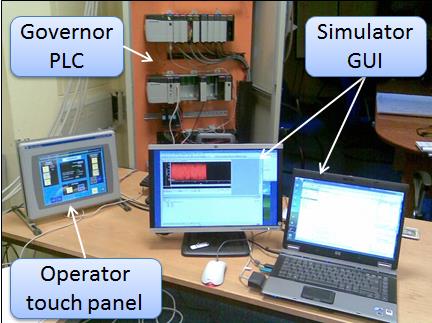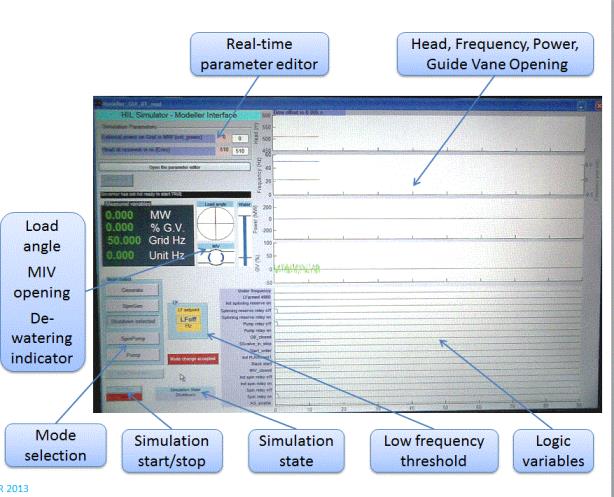Enhancing of National Grid Stability via optimisation of “Dinorwig Hydro Power Station”
Submitting Institution
Bangor UniversityUnit of Assessment
Computer Science and InformaticsSummary Impact Type
TechnologicalResearch Subject Area(s)
Mathematical Sciences: Applied Mathematics, Numerical and Computational Mathematics, Statistics
Summary of the impact
Our work has facilitated the creation of a variety of innovative control
strategies for First Hydro
Company (FHC), owner of Europe's largest pump storage plant. FHC's two
plants are both
supported by the simulation platform developed as part of our research and
responsible for
balancing load variation on the National Grid. Critically, FHC's business
model relies on their ability
to provide ancillary services within a short time. Our research produced a
comprehensive plant
model, and was used to enhance the dynamic response of the Dinorwig
station; this resulted in
improvement in National Grid stability and has provided competitive
advantages to FHC since
2008.
Underpinning research
The research underpinning this case study started in 1999 when Dr Mansoor
joined Bangor and
was awarded a research contract from FHC. Subsequently (from 2002-2012),
Bangor University's
School of Computer Science provided key R&D expertise in modelling and
simulation techniques
to analyse and improve the operation of FHC's Ffestiniog and Dinorwig
Hydro Plants.
Modelling operational performance conditions
Specifically relevant to this case study, in 1999 we developed a
comprehensive model of the
Dinorwig power station and the National Grid System. We successfully
modelled all important
aspects of the energy generation process in a way that allowed us to
simulate different operating
conditions at both the plant and on the National Grid and so predict the
performance of the station
under varying conditions [1].
Control system function analysis
In 2002 we completed a detailed analysis of the effect of National Grid
load variations on the
performance of the Dinorwig plant [2, 3]. The study demonstrated
that the original control system
was overly conservative as its control parameters were more suitable for
base load supply stations
(conventional hydro power) and not optimal for ancillary services
(frequency control). We also
found that control parameters are highly sensitive to the overall grid
load size; this led us to
conclude that the station's original control setting had been using a
non-optimal setting derived
from the assumption of a smaller than actual grid size. An improved
control system has been
developed based on existing systems; this has led to improvements in the
ancillary response time
of the station's generation system.
Subsequently, we pursued a new research direction, and in 2004 we
successfully developed new
control systems using neural networks, fuzzy logic and feed forward
techniques, for the first time at
this type of plant. These systems are have been evaluated and the results
show that it is possible
to construct a superior control system with these technologies [4, 5].
Simulation system development
The next major milestone was the development of a real time "Hardware in
the Loop" simulation
system for the Ffestiniog hydro power station in 2008, which implemented a
non-linear, multiple-input
and multiple-output (MIMO) model that provided a means to test a variety
of on-going
modifications of the station's control systems. Without the simulator the
company would have been
unable to undertake this development work. This approach provided valuable
insight into the
workings of the plant as well as allowing the testing of new control
systems prior to installation at
Ffestiniog power station [6]. In 2010, after the successful
implementation at Ffestiniog, we
developed a similar simulator with some additional functionality for
Dinorwig Power station.
 Simulator Architecture
Simulator Architecture
 Graphic User Interface
Graphic User Interface
The key members of the School of Computer Science research team involved
in this work are:
- Dr Sa'ad Mansoor, Senior lecturer and Head of the School of Computer
Science 1999-present
- Dr Dewi Jones, Senior lecturer at Bangor University 1980 - 2009.
Currently serving as a
director of Gwefr Cyf ltd.
- Dr German A. Munoz-Hernandez, Bangor University 2003 - 2007, currently
at Instituto
Tecnologico de PueblaAv. Tecnologico 420 Puebla, Mexico.
References to the research
Bangor University contributors to the following publications are
highlighted in bold, other authors
are industry partners from FHC.
[1] D.I. Jones, S.P. Mansoor, F.C. Aris, G.R. Jones, D.A.
Bradley, D.J. King, A standard
method for specifying the response of hydroelectric plant in
frequency-control mode,
Electric Power Systems Research, Volume 68(1), 19-32, 2004. (Previously
submitted to
RAE 2008). DOI: 10.1016/S0378-7796(03)00152-4
[2] D. I. Jones, Estimation of power system parameters, IEEE
Trans Power Systems, Volume
19(4), 1980-1989, 2004. DOI: 10.1109/TPWRS.2004.835671
[3] S. P. Mansoor, D. I. Jones, D. A. Bradley, C. Aris, and G.
Jones, "Reproducing oscillatory
behaviour of a hydroelectric power station by computer simulation,"
Control Engineering
Practice, Volume 8(11), pp. 1261-1272, 2000. DOI:
10.1016/S0967-0661(00)00068-X
[4] D. I. Jones, S. P. Mansoor, "Predictive feedforward control
for a hydroelectric plan," IEEE
Transaction on Control Systems Technology, Volume 12(6), 956-965, 2004.
(Previously
submitted to RAE 2008). DOI: 10.1109/TCST.2004.833405
[5] G.A Munoz-Hernandez, Gracios-Marin, CA, Diaz-Sanchez, A,
S.P. Mansoor, and D. I.
Jones, "Evaluation of neural PDF control strategy applied
to a nonlinear model of a
pumped-storage hydroelectric power station", Proc. IEEE Conference on
Informatics in
Control, Automation and Robotics, Funchal, Madeira — Portugal (2008). A
copy of this
output is available on request
[6] S. P. Mansoor, D. I. Jones, DI, Bradley, DA, Aris, C,
Jones, GR, Hardware-in-the-loop
simulation of a pumped storage hydro station, IASTED Journal of Power
and Energy
Systems, 23(2), 127-133. (Previously submitted to RAE 2008).
DOI: 10.1016/j.rser.2005.06.003
Details of the impact
The primary impact of our work has been ongoing performance
improvements on FHC plants. This
has delivered substantial economic benefits to FHC and indirectly
improved National Grid Stability.
Through the establishment of a company Gwefr Cyf Co in October 2007,
(5.1) the research
continues to feed directly into information technology consultancy
activities and benefit a range of
local and national companies.
FHC's Dinorwig plant is the largest pump storage station in the UK (the
second largest in Europe)
and therefore is vital to the National Grid infrastructure, ensuring
stability of electricity supply
nationally under highly dynamic grid-load perturbations. By generating
up to 1.8GW within 16
seconds upon demand from the grid, the plant gives the grid fast
effective energy storage. The
increasing emphasis on renewables such as wind power within the national
energy strategy,
places additional focus on the importance of FHC plants. The latter has
been highlighted by the
Chief Scientific Adviser, who has suggested that the UK needs more pump
storage plants in order
to balance the power supplied by wind turbines (5.2).
Ongoing impacts of interventions carried out 1999-2008
Our model has been utilised for numerous projects at Dinorwig since
1999. The initial modelling
[3.1], for example, was used to investigate a serious incident on the
Grid in 1999 involving
unwanted oscillations in the range 49.9 - 50.1 HZ. We demonstrated that
this was incorrectly
attributed to a problem at Dinorwig. The National Grid Regulator
originally attributed blame to FHC
and as a consequence FHC was liable for substantial contractual
penalties. The Regulator
accepted our findings however, and new control procedures were put in
place to prevent similar
events occurring in future [3.3]. This demonstrates a direct and ongoing
impact of our model on the
improved control and regulation of National Grid oscillations (5.3).
Additionally, the model has provided insight into complex interactions
between different
components of plant operating dynamics. As a direct result a new
operational strategy was put in
place using our control parameter recommendations. This lead directly to
an improvement of
around 10% to the plant's response time. Without the availability of our
modelling and simulation
techniques to develop and test it would not have been feasible to
explore new control strategies
due to operating constraints. The resulting improved performance
continues to provide direct
financial benefits to FHC and a permanent improvement to maintaining
grid stability (5.3).
Real time simulator impacts on FHC performance
In 2008, our research was used by FHC to upgrade the control system at
the Ffestiniog power
station. Prior to commissioning, the new hardware needed testing to
ensure its correct operation.
Without this reassurance, FHC could not commit to any upgrade due to the
unacceptable costs
involved with a potential failure. Our real time hardware in the loop
simulation platform
demonstrated that the proposed platform produced the same response as
the real plant across
different operating conditions [3.6]. This gave the company the
necessary confidence to
commission a new control unit in June 2008 (5.3).
In 2010, FHC planned to upgrade the control system at Dinorwig. A new
simulator platform was
developed in collaboration with Gwefr Cyf Co. [3.6], it was able to
accurately reproduce the
response of the real plant, and therefore could be used to validate the
new hardware. This lead to
the commissioning and installation of a new control unit in May 2012
(5.4).
Our findings have a direct, ongoing and fundamental impact on the FHC
plants. Without the
simulator the time required to test the new unit would be prohibitively
long and the process would
be dangerous as it could cause serious damage to the plant. Without this
work commissioning
becomes prohibitively expensive. In addition to this direct financial
impact from reduced
commissioning time-- one unit generating at 300MW for 8 hours produces
about £36,000 revenue
per day. The simulator is also being used by FHC for training purposes,
providing direct benefits in
staff knowledge and skills (5.3).
In addition, Mansoor et al. have jointly published Modelling and
Controlling Hydropower Plants; a
book that provides both practising professionals and academics with
necessary information on
models used for simulation and control analysis of hydropower stations,
enhancing the reach of the
applications and wider use of their models (ISBN 978-1-4471-2291-3
Springer 2012, see (5.1)).
Sources to corroborate the impact
(1) Company Gwefr Cyf Co. website http://www.gwefr.co.uk/
can confirm the activities of this
company.
(2) BBC news coverage on the Dinorwig plant (June 2011) is available
at:
http://www.bbc.co.uk/news/business-13725906,
including reference to the government's
chief scientific adviser on the importance of pump storage plants for
National Grid stability
in order to balance the power supplied by wind turbines.
(3) The head of Control and Instrumentation at First Hydro Company can
be contacted and can
corroborate all claims of impact of the research on First Hydro Company.
(4) An email conversation from the head of Control and Instrumentation,
First Hydro Company,
(01/08/2012) is available on request.